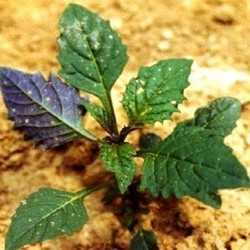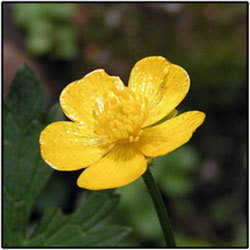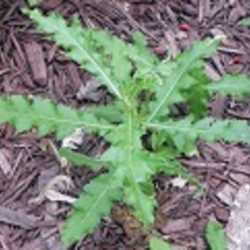What is it?
These weeds are common in a wide range of states, and are easily recognized. Of this list, five are common to all states; they are marked with an asterisk.
- Black Nightshade (Solanum americanum)
- Cocklebur*
- Creeping Buttercup (Ranunculus repens)
- Curly Dock (Rumex crispus)
- Dandelion (Taraxacum officinale)
- Ground Ivy (Glechoma hederacea)
- Henbit (Lamium amplexicaule)
- Lambs quarters* (Chenopodium album)
- Milkweed (Asclepias syriaca)
- Pennsylvania Smartweed* (Persicaria pensylvanica)
- Purslane (Portulaca oleracea)
- Ragweed* (Ambrosia spp.)
- Redroot Pigweed* (Amaranthus retroflexus)
- Thistle (Cirsium arvense)
- Wild Mustard (Sinapis arvense)
- Wild Onion (Allium canadense)
Sources of imported weeds
- Mulch
- Transplants from other gardeners or nurseries
- Bird Feeders
- Rodents: squirrels, chipmunks, mice
Weed Look-alikes
Many weeds have cultivated cousins, further complicating identification. Note the close similarities between the photographs below.
Canadian Thistle Seedlings |
Oriental Poppy early growth |
Mugwort / wild chrysanthemum |
Hardy Chrysanthemum |
Field Bindweed |
Morning Glory |
So how do you go about identifying that strange plant growing amongst your precious perennials?
- Online sources often have photograph of seedlings. These are especially helpful because they have an interactive search function.
- County extension offices and/or state agricultural offices often publish weed identification brochures.
- The Weed Finder brochure from Ortho is available free from most places selling their products.
- University of Minnesota Extension publishes "Annual Broadleaf Weed Seedling Identification" (Extension Publication 89, North Central Region).
- Cooperative Extension Service University of Georgia publishes "Common Weed Seedlings", which includes color photographs of weed seedlings, as well as details.
- Many libraries have excellent references and publications relevant to your area.
- The USDA website has a wealth of information.
The biggest question for any gardener is: How Do I Get Rid of It?!
Understanding how the weed reproduces or spreads is important in identifying how to control it. Perennial weeds are particularly hard to control. The afore-mentioned weed ID resources will include this type of information, but here are some things to note:
- Simple root systems succumb easily to foliar herbicides.
- Taproots can break, and new plant will grow from piece left behind.
- Plants that spread by stolons can intermingle with desirable plants, making use of systemic herbicide dangerous.
- Pre-emergent herbicides can eliminate the problem for the following year.
Vigilance is required to stay ahead of the weeds, especially during quality growing weather. When those first green sprouts appear in the wrong place, do your homework. Summer is for other activities than weed-pulling!
I have found the following sites helpful.
University of California Statewide Integrated Pest Management Online
Horticulture & Home Pest News Online, Iowa State University Department of Horticulture
Bayer Advanced
Weed Identifier Online. Illinois Council on Food and Agriculture Research
Ohio Perennial & Biennial Weed Guide Online. Ohio State University, OARDC Extension























